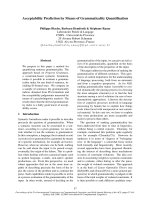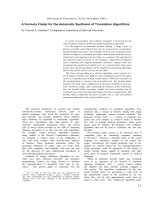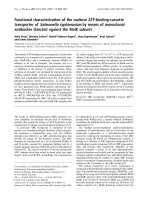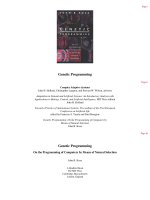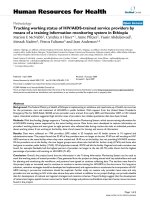Pricing Portfolio Credit Derivatives by Means of Evolutionary Algorithms doc
Bạn đang xem bản rút gọn của tài liệu. Xem và tải ngay bản đầy đủ của tài liệu tại đây (3.32 MB, 176 trang )
Svenja Hager
Pricing Portfolio Credit Derivatives
by Means of Evolutionary Algorithms
GABLER EDITION WISSENSCHAFT
Svenja Hager
Pricing Portfolio Credit
Derivatives by Means of
Evolutionary Algorithms
With a foreword by Prof. Dr Ing. Rainer Schöbel
GABLER EDITION WISSENSCHAFT
Bibliographic information published by Die Deutsche Nationalbibliothek
Die Deutsche Nationalbibliothek lists this publication in the Deutsche Nationalbibliografie;
detailed bibliographic data is available in the Internet at <>.
1st Edition 2008
All rights reserved
© Betriebswirtschaftlicher Verlag Dr.Th. Gabler | GWV Fachverlage GmbH, Wiesbaden 2008
Editorial Office: Frauke Schindler / Anita Wilke
Gabler-Verlag is a company of Springer Science+Business Media.
www.gabler.de
No part of this publication may be reproduced, stored in a retrieval system
or transmitted, mechanical, photocopying or otherwise without prior
permission of the copyright holder.
Registered and/or industrial names, trade names, trade descriptions etc. cited in this publica-
tion are part of the law for trade-mark protection and may not be used free in any form or by
any means even if this is not specifically marked.
Cover design: Regine Zimmer, Dipl Designerin, Frankfurt/Main
Printed on acid-free paper
Printed in Germany
ISBN 978-3-8349-0915-2
Dissertation Universität Tübingen, 2007
Dedicated to my parents and my beloved husband.
Foreword
Collateralized Debt Obligations (CDOs) are the most prominent example of portfolio-
related credit derivatives. They make it possible to diversify and transfer credit risk by
pooling and redistributing the risks of an underlying portfolio of defaultable assets. It
comes as no surprise that the dependence structure of portfolio assets is crucial for the
valuation of CDO tranches. The standard market model is the Gaussian copula model,
which uses only one parameter to summarize the correlations of default times in the
underlying credit portfolio. Comparable with the volatility smile from option pricing,
this simplification leads to an implied correlation smile when the model is confronted
with market data. There is a growing interest in literature searching for solutions of this
problem.
Dr. Svenja Hager contributes to this literature by extending the Gaussian copula model,
allowing for a heterogeneous specification of the dependence structure of the underlying
portfolio. She shows that heterogeneous correlation matrices are able to explain the
correlation smile. Based on this discovery, she develops a method to find the implied
correlation matrix which optimally reproduces the observed tranche spreads of a CDO
structure. To overcome the complexity of the resulting optimization problems, Evolu-
tionary Algorithms are applied successfully.
This monograph puts a new complexion on the standard market model and should there-
fore be recognized for its substantial contribution in this fascinating field of research on
credit derivatives.
Rainer Schöbel
Acknowledgements
First and foremost, I would like to express gratitude and appreciation for my advisor
Prof. Dr Ing. Rainer Schöbel. Prof. Schöbel gave me valuable academic advice and
support during my three years at the University of Tübingen. I am thankful that he
supervised my dissertation and that he provided me the freedom to do research in the
exciting area of credit risk modeling. I would also like to thank the second referee of this
thesis, Prof. Dr. Joachim Grammig, for his comments and suggestions in our internal
seminars.
Next, I record my gratitude to Dr. Axel Hager-Fingerle. His enthusiasm for science
has always encouraged me to investigate new areas of research. Numerous discussions
with him significantly improved the ideas expressed in this dissertation. I also thank Dr.
Markus Bouziane for his companionship and for providing plenty of useful information,
and Vera Klöckner for her organizational assistance. I am much obliged to Ute Hager
for her literature search and to Clemens Dangelmayr for his computational assistance.
I wish to acknowledge financial assistance of the Deutsche Forschungsgemeinschaft by
funding my research at the University of Tübingen, and of the Stiftung Landesbank
Baden-Württemberg by supporting the publication of this dissertation. Moreover, I
thank JPMorgan Chase for providing the data sets used in this study.
I am deeply grateful to my parents for being there for me every single day of my life. All
the confidence and joy that I possess is born of your love and belief in me. I am whole-
heartedly thankful for having a wonderful sister who has always been my long-distance
confidante. Above all, I want to thank my beloved husband. I am grateful for your
caring love and friendship. You make my life complete.
Svenja Hager
Table of Contents
List of Tables xvii
List of Figures x xi
List of Notations xxiii
1 Introduction 1
2 Collateralized Debt Obligations: Structure and Valuation 7
2.1 Introduction 7
2.2 CreditRiskTransferInstruments 9
2.2.1 CreditDefaultSwaps 9
2.2.2 CDSIndices 9
2.2.3 CollateralizedDebtObligations 10
2.2.3.1 ArbitrageandBalanceSheetCDOs 11
2.2.3.2 CashFlowandMarketValueCDOs 12
2.2.3.3 StaticStructuresandManagedStructures 13
2.2.3.4 CashStructuresandSyntheticStructures 13
2.2.3.5 Single-TrancheDeals 15
2.2.3.6 EffectofCorrelation 16
2.2.4 CDSIndexTranches 17
2.3 CreditRiskModeling 18
2.3.1 Single-NameCreditRisk:Intensity-BasedModels 18
2.3.1.1 StoppingTimesandtheHazardRateFunction 19
2.3.1.2 HomogeneousPoissonProcesses 22
2.3.1.3 InhomogeneousPoissonProcesses 23
2.3.1.4 CoxProcesses 24
2.3.2 Multi-NameCreditRisk:CopulaModels 25
2.3.3 ValuationofSyntheticCDOs 29
xii
2.3.3.1 Joint Distribution of Default Times in the Gaussian Cop-
ulaApproach 30
2.3.3.2 Joint Distribution of Default Times in the Gaussian One-
FactorCopulaApproach 32
2.3.3.3 Pricing the Default Leg and the Margin Leg of a CDO . 33
2.3.3.3.1 TheDefaultLeg 33
2.3.3.3.2 TheMarginLeg 34
2.3.3.4 Distribution of the Portfolio Loss in the One-Factor Ap-
proach 35
2.3.3.5 Monte-CarloSimulationofCDOTrancheSpreads 35
2.4 ValuationofCDOs:Literature 36
3 Explaining the Implied Correlation Smile 41
3.1 Introduction 41
3.2 SensitivityoftheTranchePricetotheLevelofCorrelation 42
3.3 TheImpliedTrancheCorrelation 44
3.4 TheImpliedCorrelationSmile 45
3.5 TheImpliedBaseCorrelation 47
3.6 EvolutionoftheImpliedCorrelationSmile 49
3.7 ModelingtheCorrelationSmile:Literature 56
3.8 HeterogeneousDependenceStructures 58
3.8.1 Heterogeneous Dependence Structures Can Cause Implied Corre-
lationSmiles 60
3.8.1.1 TheExistenceProblem 60
3.8.1.2 TheUniquenessProblem 61
3.8.1.3 ExemplaryHeterogeneousMatrices 62
3.8.2 Different Dependence Structures Can Lead to Identical Implied
TrancheCorrelations 63
3.8.3 Heterogeneous Dependence Structures Do Not Necessarily Lead to
ImpliedCorrelationSmiles 64
3.8.4 Heterogeneous Dependence Structures Allow for Flexible Portfolio
LossDistributions 65
3.9 Conclusion 65
4 Optimization by Means of Evolutionary Algorithms 73
4.1 Introduction 73
4.2 EvolutionaryAlgorithms 74
Ta b l e o f Cont e nts
xiii
4.3 Notation 77
4.4 EvolutionaryOperators 80
4.4.1 Selection 80
4.4.1.1 EliteSelection 80
4.4.1.2 TournamentSelection 80
4.4.1.3 ProportionalSelection 80
4.4.2 Recombination 81
4.4.2.1 FlatCrossover 81
4.4.2.2 Discrete N-PointCrossover 81
4.4.2.3 DiscreteUniformCrossover 81
4.4.2.4 IntermediateCrossover 81
4.4.2.5 ArithmeticalCrossover 81
4.4.3 Mutation 81
4.4.3.1 StandardMutation 82
4.4.3.2 GlobalMutationWithoutStrategyParameter 82
4.4.3.3 GlobalMutationWithStrategyParameter 82
4.4.3.4 LocalMutation 82
4.4.3.5 1/5-Rule 82
4.5 BasicAlgorithms 83
4.5.1 EvolutionStrategies 83
4.5.1.1 Hill-Climber 83
4.5.1.2 The (μ, λ)-Strategy and the (μ + λ)-Strategy 84
4.5.2 GeneticAlgorithms 85
4.5.3 Monte-CarloSearch 86
4.6 ParallelAlgorithms 86
4.6.1 GlobalPopulationModels 87
4.6.2 LocalPopulationModel 87
4.6.3 RegionalPopulationModels 87
4.7 EvolutionaryAlgorithmsinFinance:Literature 88
5 Evolutionary Algorithms in Finance: Deriving the Dependence Struc-
ture 91
5.1 Introduction 91
5.2 TheImpliedCorrelationStructure 92
5.3 TheOptimizationProblem 93
5.4 DescriptionoftheGenotypes 94
Ta b l e o f Cont e nts
xiv
5.4.1 TheCholeskyApproach 95
5.4.1.1 Initialization 96
5.4.1.2 RepairMechanism 96
5.4.1.3 EvaluationandProgramTermination 97
5.4.1.4 Recombination 98
5.4.1.5 Mutation 99
5.4.2 TheOne-FactorApproach 100
5.4.2.1 Initialization 100
5.4.2.2 RepairMechanism 100
5.4.3 TheClusterApproach 100
5.4.3.1 Initialization 100
5.4.3.2 RepairMechanism 101
5.5 ASystematicApproachtoDescribetheDependenceStructure 101
5.5.1 TheNearestNeighborAlgorithm 103
5.5.1.1 General Scheme of the Nearest Neighbor Algorithm . . . 104
5.6 Conclusion 107
6 Experimental Results 109
6.1 Introduction 109
6.2 SolutionEvaluation 110
6.2.1 Using the Expected Tranche Loss as Proxy for the Tranche Spread 110
6.2.2 Equivalent Information Content: Density of the Portfolio Loss and
ExpectedTrancheLoss 112
6.2.2.1 Deriving the Expected Tranche Loss from the Density of
thePortfolioLoss 113
6.2.2.2 Deriving the Density of the Portfolio Loss from the Ex-
pectedTrancheLoss 113
6.3 PerformanceComparison:BasicStrategies 113
6.3.1 Setup 113
6.3.2 Results 116
6.4 PerformanceComparison:MoreAdvancedAlgorithms 120
6.4.1 Setup 120
6.4.2 Results 122
6.4.2.1 Monte-CarloSearchvs.(1+1)-ES 125
6.4.2.2 (1+1)-ESvs.Multistart(1+1)-ES 125
6.4.2.3 (4,20)-ESvs.GA(40) 126
Ta b l e o f Cont e nts
xv
6.4.2.3.1 CholeskyApproach 127
6.4.2.3.2 One-FactorApproach 134
6.5 ImplementationofaParallelSystem 135
6.6 PerformanceComparison:ParallelAlgorithms 136
6.6.1 Setup 136
6.6.2 Results 138
6.7 DerivingtheDependenceStructureFromMarketData 138
6.8 Conclusion 141
7 Summary and Outlook 143
References 147
Ta b l e o f Cont e nts
List of Tables
6.1 The parameters ω
e
1
, ω
e
2
, ω
g
1
and ω
g
2
intheCholeskyapproach 118
6.2 The parameters ω
e
1
, ω
e
2
, ω
g
1
and ω
g
2
intheone-factorapproach. 118
6.3 The parameters ω
e
1
, ω
e
2
, ω
g
1
and ω
g
2
intheclusterapproach. 118
6.4 The parameters ω
e
1
, ω
e
2
, ω
g
1
and ω
g
2
intheCholeskyapproach 123
6.5 The parameters ω
e
1
, ω
e
2
, ω
g
1
and ω
g
2
intheone-factorapproach. 124
6.6 Speedup and efficiency obtained by parallel algorithms and parallel im-
plementation. 138
6.7 Tranchespreads(inbpsperyear) 140
6.8 Impliedtranchecorrelations 140
List of Figures
2.1 StructureofaCLN 8
2.2 StructureofaCDS 8
2.3 CDOtransactionwithcashstructure 14
2.4 Structure of a partially funded synthetic CDO. 14
2.5 Portfoliolossdistributionfordifferentlevelsofcorrelation. 17
3.1 Flatcorrelationstructure. 44
3.2 Sensitivityofthetranchespreadtothelevelofcorrelation 45
3.3 The implied correlation smile on April, 4 2005. 46
3.4 The implied base correlation skew on April, 4 2005. . . . . . . 48
3.5 CDX.NA.IG index spread. 49
3.6 CDX.NA.IG tranche spreads. 52
3.7 CDX.NA.IG implied tranche correlations. 53
3.8 Evolution of the CDX.NA.IG implied correlation smile. . 54
3.9 Sensitivity of the tranche spread to the level of correlation for different
indexspreads 55
3.10Theexistenceproblem 61
3.11Theuniquenessproblem 62
3.12 Varying the intra sector correlation and the inter sector correlation influ-
encestheimpliedcorrelationsmile. 63
3.13 Correlation smiles produced by correlation matrices with 10 clusters of
equal size. The intra sector correlation is 0.7, the inter sector correlation
variesbetween0.3and0.5 63
3.14 Correlation smiles produced by correlation matrices with 10 clusters of
equal size. The inter sector correlation is 0.3, the intra sector correlation
variesbetween0.5and0.7 64
3.15 Varying the size and the number of sectors influences the correlation smile.
The intra sector correlation is 0.7, the inter sector correlation is 0.3. . . . 67
xx
3.16 When there is only one sector of high correlation, the cluster size influences
the correlation smile. The intra sector correlation is 0.8, the inter sector
correlationis0.2. 68
3.17 Correlation matrices differing in shape but leading to identical implied
tranchecorrelations. 69
3.18 The flat correlation matrix and the correlation matrix with 5 clusters of 20
assets each lead to identical tranche spreads and consequently to identical
implied correlation parameters. These correlation matrices do not lead to
correlationsmiles 70
3.19Portfoliolossdistributionforheterogeneouscorrelationmatrices 71
5.1 Different dependence structures can lead to identical tranche spreads. . . 102
5.2 Dependencestructurescanbeorderedinasystematicway 106
6.1 The expected tranche loss vs. the tranche premium, scaling factor k=0.04274.
Notethatweuseauniquescalingfactorforalltranches. 112
6.2 Convergence behavior (mean value and quantiles): (1 + 1)-ES. 116
6.3 Convergence behavior (mean value and quantiles): (3, 12)-ES. 117
6.4 Convergence behavior (mean value): (1 + 1)-ES vs. (3, 12)-ES 120
6.5 Dependence structures leading to the desired expected tranche losses. . . 121
6.6 Convergence behavior in the Cholesky approach (mean value and quan-
tiles): (1 + 1)-ESandMonte-Carlosearch. 126
6.7 Convergence behavior in the Cholesky approach (mean value): (1+ 1)-ES
vs.Monte-Carlosearch. 126
6.8 Convergence behavior in the one-factor approach (mean value and quan-
tiles): (1 + 1)-ESandMonte-Carlosearch. 127
6.9 Convergence behavior in the one-factor approach (mean value): (1+1)-ES
vs.Monte-Carlosearch. 127
6.10ExemplarysolutionmatrixintheCholeskyapproach 128
6.11Exemplarysolutionmatrixintheone-factorapproach. 128
6.12 Convergence behavior in the Cholesky approach (mean value and quan-
tiles):EvolutionStrategies. 129
6.13 Convergence behavior in the Cholesky approach (mean value): Evolution
Strategiesincomparison 129
6.14 Convergence behavior in the one-factor approach (mean value and quan-
tiles):EvolutionStrategies. 130
List of Figures
xxi
6.15 Convergence behavior in the one-factor approach (mean value): Evolution
Strategiesincomparison 130
6.16 Convergence behavior in the Cholesky approach (mean value and quan-
tiles):GeneticAlgorithms 131
6.17 Convergence behavior in the Cholesky approach (mean value): Genetic
Algorithmsincomparison 131
6.18 Convergence behavior in the one-factor approach (mean value and quan-
tiles):GeneticAlgorithms 132
6.19 Convergence behavior in the one-factor approach (mean value): Genetic
Algorithmsincomparison 132
6.20 Cholesky approach: performance (mean value) based on evaluations. . . . 133
6.21 Cholesky approach: performance (mean value) based on generations. . . 133
6.22 One-factor approach: performance (mean value) based on evaluations. . . 135
6.23 One-factor approach: performance (mean value) based on generations. . . 135
6.24Theimpliedcorrelationmatrix. 140
6.25Fittingtheimpliedcorrelationsmile. 141
List of Figures
List of Notations
Single-Name Credit Risk
F (t) probability distribution function
F (t, T ) conditional probability distribution function
f(t) probability density function
f(t, T ) conditional probability density function
G background information
(G
t
)
t≥0
background filtration
h(t) hazard rate function
h(t, T ) conditional hazard rate function
N(t) counting process
S(t) survival function
S(t, T) conditional survival function
λ(t) intensity of the counting process N(t)
τ default time
(Ω, (F
t
)
(t≥0)
,P) filtered probability space,
the filtration F
t
describes the information structure,
P describes the risk-neutral probability measure
xxiv
Multi-Name Credit Risk
C(u
1
, ,u
n
) n-dimensional copula function
c(u
1
, ,u
n
) copula density
C
Ga
Σ
Gaussian copula
c
Ga
Σ
density of the Gaussian copula
D(t) discount factor for maturity t
E
j
exposure of asset j
F (x) probability distribution function
F (x) joint distribution function of x =(x
1
, ,x
n
)
F(x) vector of marginal probabilities (F
1
(x
1
), ,F
n
(x
n
))
F
ˆ
X
(x) probability distribution function conditional on
ˆ
X
F
ˆ
X
(x) joint distribution function conditional on
ˆ
X
I
j
(t) default indicator process of asset j
L(t) cumulative portfolio loss at time t
R
j
fractional loss given default of asset j
s
A,B
spread of tranche (A, B)
t
1
, ,t
I
regular payment dates
t
p(τ
j
)
last regular payment date before default τ
j
U random variable with uniform distribution on [0, 1]
X
1
, , X
n
standard normally distributed random variables
X
1
, ,X
n
independent standard normally distributed
idiosyncratic risk factors
ˆ
X standard normally distributed common risk factor
Σ correlation matrix
Φ univariate standard normal distribution function
Φ
n
Σ
multivariate standard normal distribution function
ω
A,B
(L) cumulative default of tranche (A, B)
List of Notations
xxv
Evolutionary Algorithms
GA(μ) Genetic Algorithm with population size μ
I search space containing all individuals
m mutation operator
P (t)={p
1
(t), , p
μ
(t)} population at time t
p =(x
1
, , x
n
,σ
1
, , σ
n
) individual having one strategy variable σ
i
for each
object variable x
i
r recombination operator
s selection operator
Z standard normally distributed random variable
ι termination criterion
λ number of offspring individuals
μ number of parent individuals
(μ, λ)-ES Evolution Strategy selecting the μ best individuals
out of λ offspring individuals to form the next
parent generation
(μ + λ)-ES Evolution Strategy selecting the μ best individuals
out of the union of μ parents and λ offspring
to form the next parent generation
Φ objective function assigning a certain fitness value
to the individuals
Ψ generation transition function
Ω set of probabilistic genetic operators
(1 + 1)-ES Hill-Climber
List of Notations
xxvi
Implied Correlation Matrix
C Cholesky decomposition
f
1
(Σ), f
2
(Σ), f
3
(Σ) functions indicating the quality of Σ
s
e
, s
m
, s
s
target spreads
s
e
(Σ), s
m
(Σ), s
s
(Σ) tranche spreads as a function of Σ
z(t) objective function indicating the quality of
the best individual found so far
ρ correlation parameter
Σ correlation matrix
σ
e
(Σ), σ
m
(Σ), σ
s
(Σ) implied tranche correlations as a function of Σ
List of Notations
xxvii
Abbreviations
ABS asset-backed security
bps basis points
CBO collateralized bond obligation
CDO collateralized debt obligation
CDO
2
CDO squared, CDO of CDOs
CDS credit default swap
cf. confer to
CLN credit linked note
CLO collateralized loan obligation
DJ CDX.NA.IG 5yr CDS index comprising a portfolio of 125 investment
grade US companies, maturity 5 years
DJ iTraxx EUR 5yr CDS index comprising a portfolio of 125 investment
grade European companies, maturity 5 years
EA Evolutionary Algorithm
e.g. for example
ES Evolution Strategy
GA Genetic Algorithm
i.e. that is
ISDA International Swaps and Derivatives Association
MBS mortgage-backed security
SF CDO structured finance CDO
SPV special purpose vehicle
STCDO single-tranche CDO
List of Notations
Chapter 1
Introduction
In recent years, the credit derivatives market has become extremely active. Especially
credit default swaps (CDSs) and collateralized debt obligations (CDOs) have contributed
to what has been an amazing development.
The most important benefit of credit derivatives is their ability to transfer the credit
risk of an arbitrary number of obligors in a simple, efficient, and standardized way, giv-
ing rise to a liquid market for credit risk that can be easily accessed by many market
participants.
Credit risk management, the traditional area of application for credit derivatives, has
gained additional importance due to the high number of downgrades and credit events
over recent years. For financial service institutions, such as banks, the exchange of credit
risk is an interesting means of risk management, as long as it allows for maintenance of
the client relationship. Eliminating the credit risk of a client by simply selling the risky
item is generally not an option. By the use of credit derivatives, the credit risk can be
removed from the balance sheet without having to sell the risky asset.
This general tendency in the credit derivatives market was intensified by a number of
economic factors including low interest rates, which focused the attention of market
participants on high-yield sectors. Compared to traditional investment products, credit
derivatives provide relatively high yields. Consequently, they are not only used to manage
credit risk, they are also established as investment instruments. Another contributing
factor to the growth in the credit derivatives market is the high regulatory demand on
the credit risk control side.
Major groups participating in the market for credit derivatives are banks, insurance and
reinsurance companies, hedge funds, investment funds, and industrials. These market
participants use credit derivatives for various purposes. Banks generally buy credit pro-
tection. They use credit derivatives to manage their regulatory capital requirements
2 Chapter 1. Introduction
(regulatory arbitrage) and to exploit funding opportunities by the securitization of loan
portfolios (funding arbitrage). In addition, banks use credit derivatives for trading rea-
sons. Insurance companies, reinsurance companies, and investment funds are essential
providers of credit protection, buying credit risk in order to obtain a competitive yield.
They also use credit derivatives for credit risk management of their bond portfolios.
Hedge funds invest in credit derivatives so as to gain on relative value trades between
different markets, e.g. the bond market and the CDS market. They are also attracted by
the high levels of leverage that can be achieved in many credit derivative transactions.
The market for single-name CDSs has become rather liquid with entire term structures
of CDS margins available for an increasing number of reference assets. As a result, CDSs
are considered to be “plain vanilla” instruments, while CDS premia are used to calibrate
pricing models for more complex derivative products. Even more than in other markets,
it is important to fully understand the basic pricing model, since credit markets are
incomplete.
Since 2003, the credit risk of standardized portfolios has been summarized in CDS in-
dices. On these index portfolios CDO tranches are now actively quoted. Thus, the
portfolio loss distribution and the asset correlation as seen by market participants have
become an observable variable in as much as quoted tranche premia can be interpreted
as aggregating the market’s view of dependence among the underlying assets.
According to e.g. Burtschell et al. (2005a), Duffie (2004), Finger (2004), Friend and
Rogge (2004), Hull and White (2004), and Schönbucher (2003) the market has con-
verged to a standard model for the pricing of index tranches. A one-factor Gaussian
copula approach, essentially along the lines of Vasicek (1987) and Li (2000), is consid-
ered to be the benchmark in a manner reminiscent of the Black and Scholes (1973) model
for option pricing. The standard market model assumes in its simplest version that the
copula correlations between each pair of assets are the same. This assumption is fre-
quently used in the market according to Burtschell et al. (2005a), Duffie (2004), Finger
(2004), Hull and White (2004), and McGinty et al. (2004). We denote such a correlation
structure as homogeneous or flat (see Burtschell et al. (2005b)). Using this approach,
an implied correlation parameter which is not directly observed in the market can be
derived from quoted CDO tranche prices, similar to the implied volatility parameter in
option markets. CDO tranches are often quoted in terms of this correlation parameter.
However, different correlation levels are needed to reproduce the market prices of differ-
ent tranches on the same underlying portfolio (see Andersen and Sidenius (2004) and
Gregory and Laurent (2004)). This phenomenon illustrates that the standard market
model is not able to consistently reproduce market prices. Even more than in the case
Chapter 1. Introduction 3
of the Black and Scholes model, the shortcomings of the one-factor Gaussian copula ap-
proach are acknowledged by practitioners and academics alike. Trading correlation was
originally considered as simply trading a new asset class. But still, market participants
are far from fully understanding the correlation concept and the measurement issues it
entails.
Aside from liquidity and transparency, the variety of derivative products is increasing.
Products range from single-name credit default swaps and basket credit default swaps
to more sophisticated products like derivatives on credit derivatives. Examples of exotic
multi-name credit derivatives are so-called bespoke single-tranche CDOs (STCDOs), for-
ward starting STCDOs, STCDOs with embedded options, outright options on STCDOs
or on indices, and CDOs of CDOs (CDO
2
) as mentioned in Schönbucher (2006). A com-
parable evolution towards exotic products could formerly be observed in option markets.
Although substantial progress in the pricing of portfolio credit derivatives is being made,
pricing capacities are still not where they were during the emergence of exotic options.
With the recent development of non-standard credit derivatives, it has become increas-
ingly important to develop pricing models for these illiquid products that are consistent
with the pricing models and the market quotes of related liquid instruments. In our
study, we aim at pricing non-standard illiquid portfolio credit derivatives which are re-
lated to standard CDO tranches in as much as they have the same underlying portfolio
of obligors. Now standard CDO tranches are actively traded in the market. To en-
sure consistent pricing, we have to calibrate our pricing model to the observed market
prices of these standard CDO tranches. We have to make sure that the calibrated model
comprises all market information of relevance to the pricing of the particular illiquid in-
strument. Then we use the calibrated model to determine the price of the non-standard
contract.
As mentioned above, the standard market approach is generally not able to reproduce
all quoted tranche spreads of a CDO structure simultaneously. The inability of the stan-
dard market model to fit market prices led to the development of numerous extended
and generalized pricing methods. Examples are Gregory and Laurent (2004), Andersen
and Sidenius (2004), Hull and White (2004), Kalemanova et al. (2005), Joshi and Stacey
(2005), Moosbrucker (2006), Baxter (2006), Hull et al. (2005), Willemann (2005b), Hull
and White (2006), Tavares et al. (2004), Mashal et al. (2004), van der Voort (2005), and
Schönbucher (2006). We discuss these models in Section 3.7. In this study we hold on
to the Gaussian copula approach. But instead of assuming a flat correlation structure as
in the standard market model, we focus on the use of heterogeneous correlation struc-
tures. Even if a flat correlation structure is appealing because of its intuitive simplicity,
